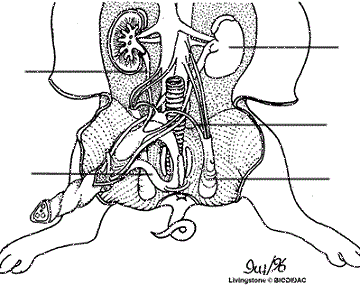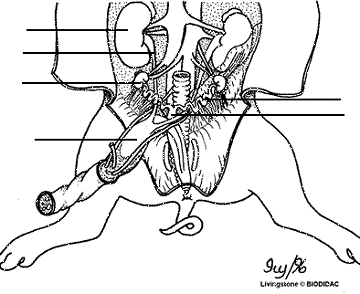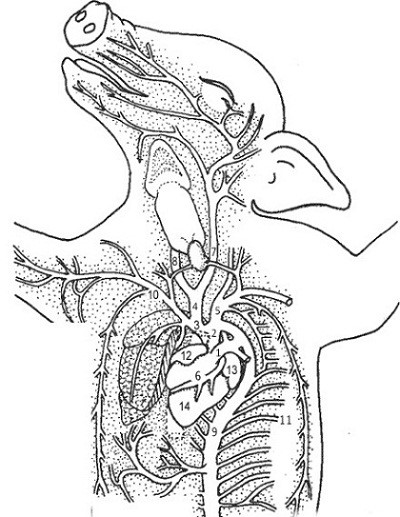Plant and animal bodies are dissected to analyze the structure and function of their components. Dissection is cutting into a dead animal to learn about the anatomy or physiology of the animal. Dissection is used to help to determine the cause of death in an autopsy (called necropsy in other animals) and is an intrinsic part of forensic medicine.

Fetal Pig Dissection - External Anatomy
Determine the sex of your pig by looking for the urogenital opening. In females, this opening is located near the anus. In males, the opening is located near the umbilical cord.
If your pig is female, you should also note that urogenital papilla is present near the genital opening. Males do not have urogenital papilla.
Both males and females have rows of nipples, and the umbilical cord will be present in both.
Make sure you are familiar with terms of reference: anterior, posterior, dorsal, ventral. In addition, you'll need to know the following terms:
- Medial: toward the midline or middle of the body
- Lateral: toward the outside of the body
- Proximal: close to a point of reference
- Distal: farther from a point of reference
In the pig's mouth locate the hard and soft palate on the roof of the mouth. Can you feel your own hard and soft palates with your tongue?
The taste buds (also known as sensory papillae) on the side of the tongue. Locate the oesophagus at the back of the mouth. Feel the edge of the mouth for teeth.
The epiglottis, a cone-shaped structure at the back of the mouth, a flap of skin helps to close this opening when a pig swallow. The pharynx is the cavity in the back of the mouth - it is the junction for food (oesophagus) and air (trachea).
Gestation for the fetal pig is 112-115 days. The length of the fetal pig can give you a rough estimate of its age.
- 11mm - 21 days | 17 mm - 35 days | 2.8 cm - 49 days
- 4 cm - 56 days | 22 cm - 100 days | 30 cm - birth
Observe the toes of the pig.
Observe the eyes of the pig, and carefully remove the eyelid so that you can view the eye underneath. Does it seem well developed? Do you think pigs are born with their eyes open or shut?
Carefully lay the pig on one side in your dissecting pan and cut away the skin from the side of the face and upper neck to expose the masseter muscle that works the jaw, lymph nodes, and salivary glands. The salivary glands kind of look like chewing gum and are often lost if you cut too deeply.
The Anatomy of the Fetal Pig (Internal)
The Incision
Place your fetal pig in the dissecting pan ventral side up. Use string to "hog-tie" your pig so that the legs are spread eagle and not in your way. Use scissors to cut through the skin and muscles according to the diagram. Do not remove the umbilical cord. In the first section, you will only examine the abdominal cavity (the area below the ribcage).
After completing the cuts, locate the umbilical vein that leads from the umbilical cord to the liver. You will need to cut this vein in order to open up the abdominal cavity.
Your pig may be filled with water and preservative, drain over the sink if necessary and rinse organs. Locate each of the organs below, check the box
Diaphragm. This muscle divides the thoracic and abdominal cavity and is located near the ribcage. The diaphragm aids in breathing.
Liver. This structure is lobed and is the largest organ in the body. The liver is responsible for making bile for digestion.
Gall bladder. This greenish organ is located underneath the liver; the bile duct attaches the gall bladder to the duodenum. The gall bladder stores bile and sends it to the duodenum, via the bile duct.
Stomach. A pouch-shaped organ that rests just underneath and to the pig's left. At the top of the stomach, you'll find the oesophagus. The stomach is responsible for churching and breaking down food.
- At each end of the stomach are valves that regulate food entering and leaving the stomach. At the oesophagus is the cardiac sphincter valve, and at the duodenum is the pyloric sphincter valve. View the inside of the stomach by slicing it open lengthwise.
- The stomach leads to the small intestine, which is composed of the duodenum (straight portion just after the stomach) and the ileum (curly part).
- The ileum is held together by the mesentery. In the small intestine, further, digestion occurs and nutrients are absorbed through the arteries in the mesentery. These arteries are called mesenteric arteries.
Pancreas: a bumpy organ located along the underside of the stomach, a pancreatic duct leads to the duodenum. The pancreas makes insulin, which is necessary for the proper uptake of sugars from the blood.
Spleen: a flattened organ that lies across the stomach and toward the extreme left side of the pig. The spleen stores blood and is not part of the digestive system. On the underside of the spleen, locate the splenic artery.
At the end of the ileum, where it widens to become the large intestine, a "dead-end" branch is visible. This is the cecum. The cecum helps the pig digest plant material.
- The large intestine can be traced to the rectum. The rectum lies toward the back of the pig and will not be moveable. The rectum opens to the outside of the pig, or the anus. The large intestine reabsorbs water from the digested food, any undigested food is stored in the rectum as faeces.
Kidneys: Lying on either side of the spine are two bean-shaped organs: the kidneys. The kidneys are responsible for removing harmful substances from the blood, these substances are excreted as urine. (More on this later)
Two umbilical vessels can be seen in the umbilical cord, and the flattened urinary bladder lies between them.
Urinary and Reproductive Systems
Locate the kidneys; the tubes leading from the kidneys that carry urine are the ureters.
The ureters carry urine to the urinary bladder - located between the umbilical vessels.
Lift the bladder to locate the urethra, the tube that carries urine out of the body.
The vessels that attach to the kidney - are the renal vessels.
Male
Find the scrotal sacs at the posterior end of the pig (between the legs), testis is located in each sac. Open the scrotal sac to locate the testis.
On each testis, find the coiled epididymis. Sperm cells produces in the teste pass through the epididymis and into a tube called the vas deferens (in humans, a vasectomy involves cutting this tube).
The penis can be located by cutting away the skin on the flap near the umbilical cord. This tube-like structure eventually exits out the urogenital opening, also known as the urethra.

Female
In the female pig, locate two bean-shaped ovaries located just posterior to the kidneys and connected to the curly oviducts.
Trace the oviducts toward the posterior to find that they merge at the uterus. Trace the uterus to the vagina. The vagina will actually appear as a continuation of the uterus.

Dissection of the Thoracic Cavity

You may need to cut through the pig's sternum and expose the chest cavity (thoracic cavity) to view. You will need to cut all the way up into the pig's neck, almost to the chin and open the thoracic cavity. Identify each of the following organs.
- Find the diaphragm again. Remember that the diaphragm separates the abdominal cavity from the thoracic cavity, and it aids in breathing. Above the diaphragm, the centre of the chest is the heart.
- Remove the pericardium, which is a thin membrane that surrounds the heart.
- The structures visible on the heart are the two atria (12,13), and the ventricle (14) which have two chambers not visible from the outside.
- The most obvious vessel in the front of the heart is the pulmonary trunk (1). It curves upward and joins the aorta (2) - a vessel that arches from the heart and curves around to go to the lower part of the body -where it is called the abdominal (dorsal) aorta (9). The aorta supplies the body with blood.
- The aorta will curve back and then branch in two spots - the right brachiocephalic (3) and the left subclavian (5)
- The right brachiocephalic then branches into arteries - the common carotid (4) and the right subclavian (10) The subclavian supply blood to the arms and follow the clavicle bone
- The common carotid (4), will branch into the left (7) and right carotid arteries (8). The carotid arteries supply blood to the head and neck.
- Observe the coronary vessels (6) on the outside of the heart - these vessels supply blood to the muscle of the heart.
- Easy arteries to find are the ones that run near the ribs. These are the intercostal arteries (11).
- Lift the heart to look on its dorsal side (toward the back), you should be able to see the anterior and posterior vena cava, which brings blood from the body back to the heart. In addition, you should also be able to find the left and right jugular veins that drain blood from the head and run parallel to the carotids.
- Push the heart to the side to locate two spongy lungs located on the left and right sides. The lungs are connected to bronchial tubes (not visible) which connect to the trachea (forming a Y).
- The trachea is easy to identify due to the cartilaginous rings, which help keep it from collapsing as the animal inhales and exhales. The trachea should be located in the chin area above the heart.
- Lying atop the trachea, locate the pinkish-brown, V-shaped structure called the thyroid gland. This gland secretes hormones that control growth and metabolism.
- At the anterior (toward the head) of the trachea, you can find the hard light coloured larynx (or voice box). The larynx allows the pig to produce sounds - grunts and oinks.
Fetal Pig - Dissection of the Lower Arteries
Trace the abdominal aorta (also called the dorsal aorta) to the lower part of the body, careful tweezing of the tissue will reveal several places where it branches, though some of the arteries may have been cut when you removed organs of the digestive system.
The hepatic artery leads to the liver. (may not be visible)
The splenic artery leads to the spleen (may not be visible)
The renal arteries leading to the kidney.
The mesenteric artery leads to the mesentery and branches into many smaller vessels. Look in the small intestine to find this artery.
Trace the abdominal aorta and note where it joins the umbilical arteries. You will need to cut the muscle in the leg to trace the next vessels. Use a pin to carefully tease away the surrounding muscle and tissue.
The abdominal aorta splits into two large vessels that lead to each leg - the external iliac arteries will turn into the femoral arteries as they enter the leg
Follow the umbilical artery toward the pig, you'll find that it branches, and a small artery stretches toward the posterior of the pig - this is the iliolumbar artery.
Follow the external iliac into the leg (carefully tease away muscle), it will branch into two arteries: the femoral (toward the outside of the leg) and the deep femoral (toward the back of the leg)
Click here to view a video that explains dissection.